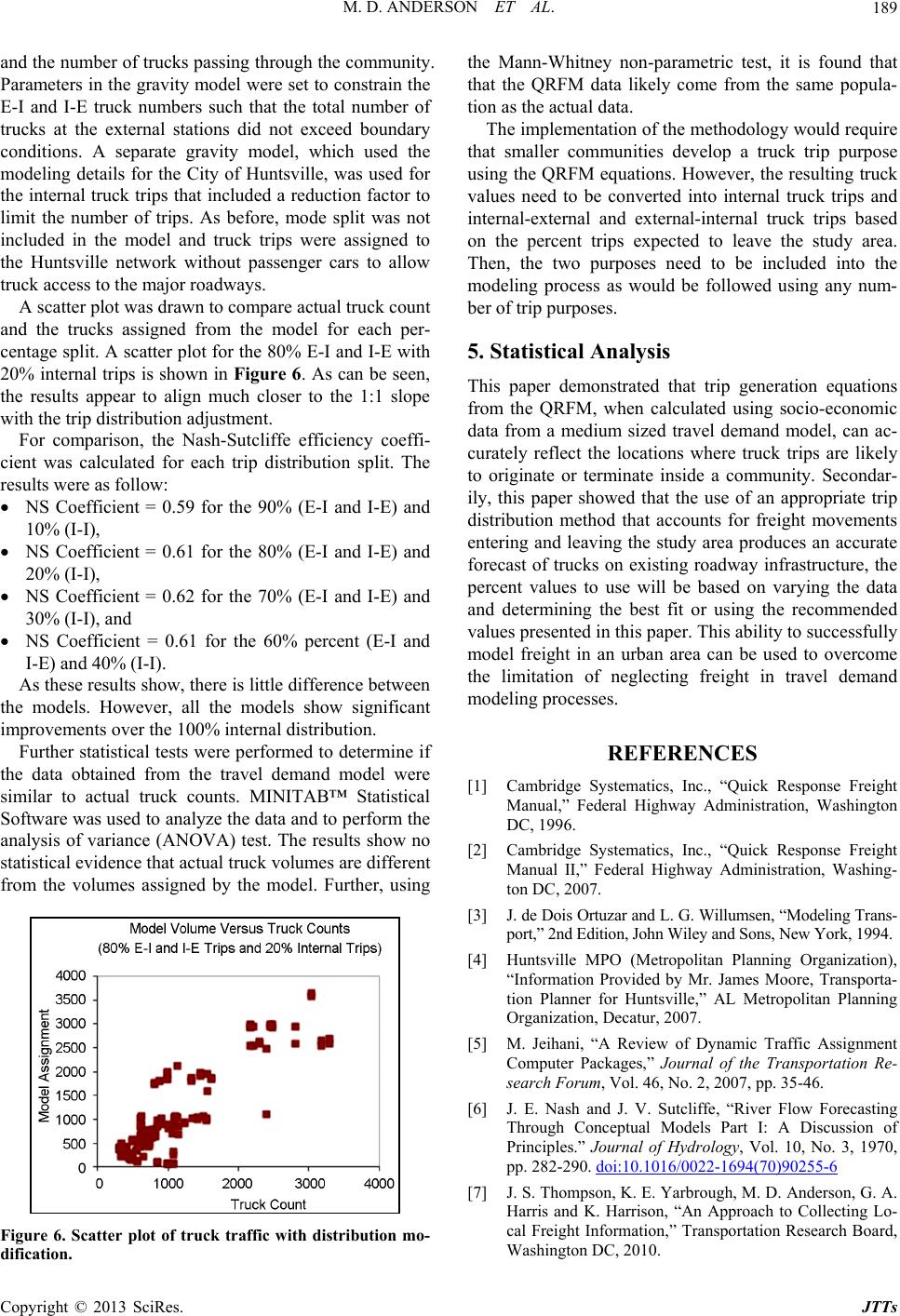
M. D. ANDERSON ET AL. 189
and the number of trucks passing through the community.
Parameters in the gravity model were set to constrain the
E-I and I-E truck numbers such that the total number of
trucks at the external stations did not exceed boundary
conditions. A separate gravity model, which used the
modeling details for the City of Huntsville, was used for
the internal truck trips that included a reduction factor to
limit the number of trips. As before, mode split was not
included in the model and truck trips were assigned to
the Huntsville network without passenger cars to allow
truck access to the major roadways.
A scatter plot was drawn to compare actual truck count
and the trucks assigned from the model for each per-
centage split. A scatter plot for the 80% E-I and I-E with
20% internal trips is shown in Figure 6. As can be seen,
the results appear to align much closer to the 1:1 slope
with the trip distribution adjustment.
For comparison, the Nash-Sutcliffe efficiency coeffi-
cient was calculated for each trip distribution split. The
results were as follow:
NS Coefficient = 0.59 for the 90% (E-I and I-E) and
10% (I-I),
NS Coefficient = 0.61 for the 80% (E-I and I-E) and
20% (I-I),
NS Coefficient = 0.62 for the 70% (E-I and I-E) and
30% (I-I), and
NS Coefficient = 0.61 for the 60% percent (E-I and
I-E) and 40% (I-I).
As these results show, there is little difference between
the models. However, all the models show significant
improvements over the 100% internal distribution.
Further statistical tests were performed to determine if
the data obtained from the travel demand model were
similar to actual truck counts. MINITAB™ Statistical
Software was used to analyze the data and to perform the
analysis of variance (ANOVA) test. The results show no
statistical evidence that actual truck volumes are different
from the volumes assigned by the model. Further, using
Figure 6. Scatter plot of truck traffic with distribution mo-
dification.
the Mann-Whitney non-parametric test, it is found that
that the QRFM data likely come from the same popula-
tion as the actual data.
The implementation of the methodology would require
that smaller communities develop a truck trip purpose
using the QRFM equations. However, the resulting truck
values need to be converted into internal truck trips and
internal-external and external-internal truck trips based
on the percent trips expected to leave the study area.
Then, the two purposes need to be included into the
modeling process as would be followed using any num-
ber of trip purposes.
5. Statistical Analysis
This paper demonstrated that trip generation equations
from the QRFM, when calculated using socio-economic
data from a medium sized travel demand model, can ac-
curately reflect the locations where truck trips are likely
to originate or terminate inside a community. Secondar-
ily, this paper showed that the use of an appropriate trip
distribution method that accounts for freight movements
entering and leaving the study area produces an accurate
forecast of trucks on existing roadway infrastructure, the
percent values to use will be based on varying the data
and determining the best fit or using the recommended
values presented in this paper. This ability to successfully
model freight in an urban area can be used to overcome
the limitation of neglecting freight in travel demand
modeling processes.
REFERENCES
[1] Cambridge Systematics, Inc., “Quick Response Freight
Manual,” Federal Highway Administration, Washington
DC, 1996.
[2] Cambridge Systematics, Inc., “Quick Response Freight
Manual II,” Federal Highway Administration, Washing-
ton DC, 2007.
[3] J. de Dois Ortuzar and L. G. Willumsen, “Modeling Trans-
port,” 2nd Edition, John Wiley and Sons, New York, 1994.
[4] Huntsville MPO (Metropolitan Planning Organization),
“Information Provided by Mr. James Moore, Transporta-
tion Planner for Huntsville,” AL Metropolitan Planning
Organization, Decatur, 2007.
[5] M. Jeihani, “A Review of Dynamic Traffic Assignment
Computer Packages,” Journal of the Transportation Re-
search Forum, Vol. 46, No. 2, 2007, pp. 35-46.
[6] J. E. Nash and J. V. Sutcliffe, “River Flow Forecasting
Through Conceptual Models Part I: A Discussion of
Principles.” Journal of Hydrology, Vol. 10, No. 3, 1970,
pp. 282-290. doi:10.1016/0022-1694(70)90255-6
[7] J. S. Thompson, K. E. Yarbrough, M. D. Anderson, G. A.
Harris and K. Harrison, “An Approach to Collecting Lo-
cal Freight Information,” Transportation Research Board,
Washington DC, 2010.
Copyright © 2013 SciRes. JTTs